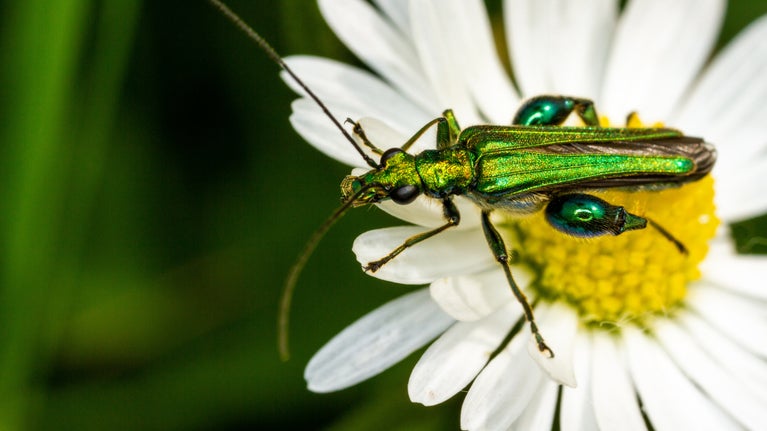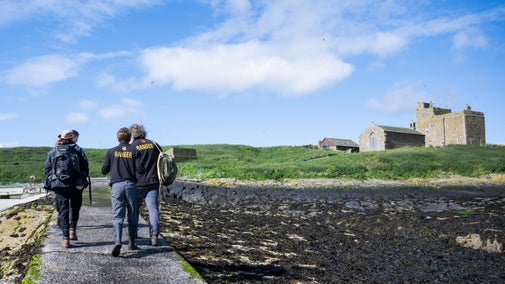
Get closer to wildlife
Discover tips for spotting mammals, birds and insects each season and learn about the range of wildlife at the places we look after.

The puffin is one of the country's favourite birds and there are few better places to see them up close than at the places in our care. Learn all about their diet, when they breed and the best time of year to see puffins up close.
With its beautiful markings, strikingly coloured bill and comic gait, the puffin is a bird that has endeared itself to millions. You might have heard them being called ‘sea parrots’, but in Northumberland the puffin is also known as a 'tommy noddy'.
Puffins are members of the auk family, alongside guillemots and razorbills. Male and female puffins look almost identical, though the male is often slightly larger. They live longer than you might think – many live to be over 20 years old and some have been recorded at over 30 years old.
Puffins may appear awkward or clumsy on land or when they’re flying. But, like most seabirds, they show off their agility underwater. While steering with their feet, puffins’ wings become flippers, propelling them down at great speed to catch their next meal. During breeding season you’ll see them arriving back to land with their colourful bills full of sand eels, a key staple of their diet.
In peak season tens of thousands of birds search for food in the North Sea. The health of the waters around the islands and the marine environment is crucial to the survival of these birds.
When they’re not with the breeding colony, puffins shed their brightly coloured bills in favour of a dull grey winter bill. But as spring approaches the vibrant colours return to breeding birds and the transformation is complete by the time they settle on land again.

Puffins nest in rabbit-like burrows. As the puffins return to the breeding colonies, they start cleaning their burrows and making a fresh nest for the months ahead. They burrow out the peaty earth to create a chambered hollow underground in which a single egg will be laid.
Puffins often return to the same partner and you may see them reinforcing their pair bonds by ‘billing’ – rubbing their bills together.
The egg is normally incubated for around 40 days. When the chick, called a puffling, hatches, it looks nothing like the adult birds – it's a little charcoal-coloured ball of fluff. The puffling will continue to develop over a period of 40 days or so before it’s ready to see the world for the first time.
You may see black-headed gulls trying to steal fish from the puffins returning to feed their chicks. This behaviour, known as kleptoparasitism, is a response to a seasonal abundance of food. Most puffins are wily and able to avoid the robbing birds, having sometimes travelled many miles to their favourite fishing spots.
When a chick has grown large enough, it eventually emerges for a clumsy waddle down to the water's edge to be introduced to the sea, its future home.

Home to one of the largest colonies in the UK, puffins have lived on the Farne Islands for decades, thanks to good local sources of food, a lack of ground predators such as rats, and the availability of suitable nesting areas.
In the summer months there are around 21,000 puffins on the island of Skomer in the Marloes Peninsula in Pembrokeshire, Wales. Next to Skomer is Skokholm Island that is also a favourite with seabirds including razorbills, guillemots, manx shearwaters and a strong colony of puffins.
Both islands are owned and run by the Wildlife Trust of South and West Wales. Other puffin destinations include Lundy Island in Devon and Spyway in Dorset.

Discover tips for spotting mammals, birds and insects each season and learn about the range of wildlife at the places we look after.

Find out more about how we care for Farne Islands in Northumberland, from repairing the boardwalks to surveying seals and ringing birds to track their movements.

The puffin is one of Britain’s best loved birds and if you’re really lucky you might catch a glimpse of them at Spyway, where a small colony return each year.

Looking to catch a glimpse of a red squirrel or a rare butterfly? Follow our top tips for getting up close (but not too close) with wildlife.

Take a look at our guidelines for responsible seal spotting and top tips for seal watching.